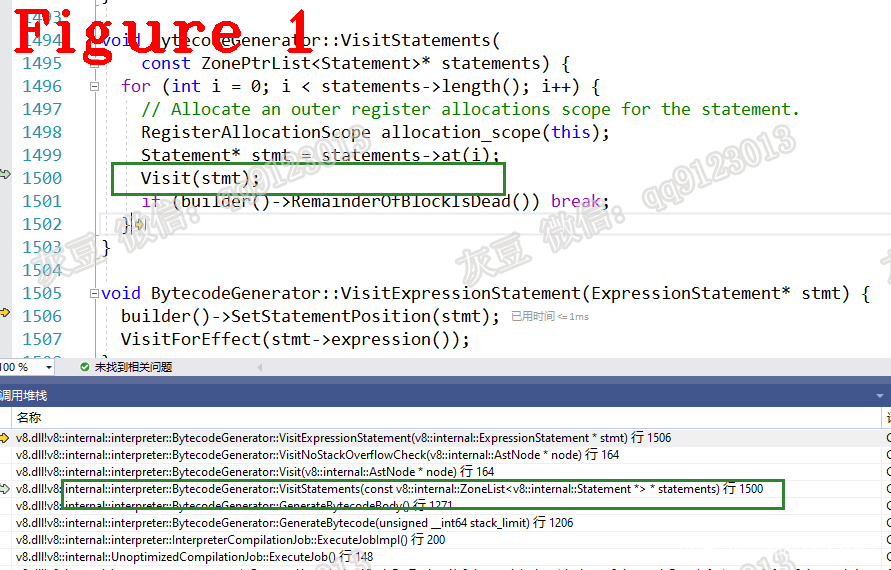1 摘要
本篇是编译链专题的第三篇,详细讲解AST到字节码的转换过程。本文组织方式:字节码生成(章节2);延期常量池(章节3);编译收尾工作(章节4)。
2.字节码生成
把AST树翻译成字节码,入口函数源码如下:
1. MaybeHandle<SharedFunctionInfo> GenerateUnoptimizedCodeForToplevel(
2. Isolate* isolate, ParseInfo* parse_info, AccountingAllocator* allocator,
3. IsCompiledScope* is_compiled_scope) {
4. //省略............
5. while (!functions_to_compile.empty()) {
6. //省略............
7. if (job->ExecuteJob() == CompilationJob::FAILED ||
8. FinalizeUnoptimizedCompilationJob(job.get(), shared_info, isolate) ==
9. CompilationJob::FAILED) {
10. return MaybeHandle<SharedFunctionInfo>();
11. }
12. if (FLAG_stress_lazy_source_positions) {
13. SharedFunctionInfo::EnsureSourcePositionsAvailable(isolate, shared_info);
14. }
15. if (shared_info.is_identical_to(top_level)) {
16. *is_compiled_scope = shared_info->is_compiled_scope();
17. DCHECK(is_compiled_scope->is_compiled());
18. }
19. }
20. parse_info->ResetCharacterStream();
21. return top_level;
22. }
上面第7行代码job->ExecuteJob()的作用是生成字节码,它与AST一样以函数为单位生成字节码,最终进入下面的源码:
1. void BytecodeGenerator::GenerateBytecodeBody() {
2. VisitArgumentsObject(closure_scope()->arguments());
3. VisitNewTargetVariable(closure_scope()->new_target_var());
4. FunctionLiteral* literal = info()->literal();
5. if (IsResumableFunction(literal->kind())) {
6. BuildGeneratorObjectVariableInitialization();
7. }
8. if (FLAG_trace) builder()->CallRuntime(Runtime::kTraceEnter);
9. //省略.........................
10. BuildIncrementBlockCoverageCounterIfEnabled(literal, SourceRangeKind::kBody);
11. VisitDeclarations(closure_scope()->declarations());
12. VisitModuleNamespaceImports();
13. builder()->StackCheck(literal->start_position());
14. if (IsBaseConstructor(function_kind())) {
15. if (literal->requires_brand_initialization()) {
16. BuildPrivateBrandInitialization(builder()->Receiver());
17. }
18. if (literal->requires_instance_members_initializer()) {
19. BuildInstanceMemberInitialization(Register::function_closure(),
20. builder()->Receiver());
21. }
22. }
23. VisitStatements(literal->body());
24. if (!builder()->RemainderOfBlockIsDead()) {
25. builder()->LoadUndefined();
26. BuildReturn();
27. }
28. }
上面第11行代码的作用是分析全局变量、生成bytecode。分析样例代码的全局变量时会执行以下功能:
1. BytecodeArrayBuilder& BytecodeArrayBuilder::LoadConstantPoolEntry(
2. size_t entry) {
3. OutputLdaConstant(entry);
4. return *this;
5. }
6. //分隔线============================
7. #define DEFINE_BYTECODE_OUTPUT(name, ...)
上面第3行代码的作用是把全局变量名称写入常量池(稍后解释)。在Bytecode运行期间,通过LdaGlobal指令取出常量值。OutputLdaConstant()方法由宏模板DEFINE_BYTECODE_OUTPUT实现,请读者自行展开。最终进入EmitBytecode()方法,该方法会生成字节码,源码如下:
1. void BytecodeArrayWriter::EmitBytecode(const BytecodeNode* const node) {
2. //省略..........
3. for (int i = 0; i < operand_count; ++i) {
4. switch (operand_sizes[i]) {
5. case OperandSize::kNone:
6. UNREACHABLE();
7. break;
8. case OperandSize::kByte:
9. bytecodes()->push_back(static_cast<uint8_t>(operands[i]));
10. break;
11. case OperandSize::kShort: {
12. uint16_t operand = static_cast<uint16_t>(operands[i]);
13. const uint8_t* raw_operand = reinterpret_cast<const uint8_t*>(&operand);
14. bytecodes()->push_back(raw_operand[0]);
15. bytecodes()->push_back(raw_operand[1]);
16. break;
17. }
18. case OperandSize::kQuad: {
19. const uint8_t* raw_operand =
20. reinterpret_cast<const uint8_t*>(&operands[i]);
21. bytecodes()->push_back(raw_operand[0]);
22. bytecodes()->push_back(raw_operand[1]);
23. bytecodes()->push_back(raw_operand[2]);
24. bytecodes()->push_back(raw_operand[3]);
25. break;
26. }
27. }
28. }
29. }
根据case条件生成不同的Bytecdoe,把Bytecdoe用bytecodes()->push_back()写入BytecodeArray。
返回到GenerateBytecodeBody()的第23行代码,VisitStatements()的作用是分析AST并生成Bytecode,源码如下:
void BytecodeGenerator::VisitStatements(
const ZonePtrList<Statement>* statements) {
for (int i = 0; i < statements->length(); i++) {
// Allocate an outer register allocations scope for the statement.
RegisterAllocationScope allocation_scope(this);
Statement* stmt = statements->at(i);
Visit(stmt);
if (builder()->RemainderOfBlockIsDead()) break;
}
}
遍历AST生成Bytecode时,会递归调用VisitStatements()方法,图1给出了调用堆栈,供读者分析。
3 延期常量池
注意 常量不是编程语言中的常量,而是编译器生成的包括各种标识符在内的信息表,即延期常量池,请注意区分!延期的含义是要为在编译阶段无法确定的执行路径预留位置,待后面确定时再填充,举例说明如下:
function test(x)
{
if(x>0)
add3(x);//x=x+3
dosomething........
}
生成test()的字节码时,要把add3()的调用地址填充到常量池中。如果此时add3()还没有被编译,就预留一个位置,等到add3()有调用地址时再填充,这就是延期填充。
生成字节码的入口函数如下:
1. Handle<BytecodeArray> BytecodeGenerator::FinalizeBytecode(
2. Isolate* isolate, Handle<Script> script) {
3. DCHECK_EQ(ThreadId::Current(), isolate->thread_id());
4. AllocateDeferredConstants(isolate, script);
5. if (block_coverage_builder_) {
6. info()->set_coverage_info(
7. isolate->factory()->NewCoverageInfo(block_coverage_builder_->slots()));
8. if (FLAG_trace_block_coverage) {
9. info()->coverage_info()->Print(info()->literal()->GetDebugName());
10. }
11. }
12. if (HasStackOverflow()) return Handle<BytecodeArray>();
13. Handle<BytecodeArray> bytecode_array = builder()->ToBytecodeArray(isolate);
14. if (incoming_new_target_or_generator_.is_valid()) {
15. bytecode_array->set_incoming_new_target_or_generator_register(
16. incoming_new_target_or_generator_);
17. }
18. return bytecode_array;
19. }
上面第4行代码的作用是构建延期常量池(DeferredConstants),源码如下:
1. void BytecodeGenerator::AllocateDeferredConstants(Isolate* isolate,
2. Handle<Script> script) {
3. // Build global declaration pair arrays.
4. for (GlobalDeclarationsBuilder* globals_builder : global_declarations_) {
5. Handle<FixedArray> declarations =
6. globals_builder->AllocateDeclarations(info(), script, isolate);
7. if (declarations.is_null()) return SetStackOverflow();
8. builder()->SetDeferredConstantPoolEntry(
9. globals_builder->constant_pool_entry(), declarations);
10. }
11. // Find or build shared function infos.
12. for (std::pair<FunctionLiteral*, size_t> literal : function_literals_) {
13. //省略..................
14. }
15. // Find or build shared function infos for the native function templates.
16. for (std::pair<NativeFunctionLiteral*, size_t> literal :
17. native_function_literals_) {
18. //省略..................
19. }
20. // Build object literal constant properties
21. for (std::pair<ObjectLiteral*, size_t> literal : object_literals_) {
22. ObjectLiteral* object_literal = literal.first;
23. //省略..................
24. }
25. }
26. // Build array literal constant elements
27. for (std::pair<ArrayLiteral*, size_t> literal : array_literals_) {
28. //省略..................
29. }
30. // Build class literal boilerplates.
31. for (std::pair<ClassLiteral*, size_t> literal : class_literals_) {
32. //省略..................
33. }
34. // Build template literals.
35. for (std::pair<GetTemplateObject*, size_t> literal : template_objects_) {
36. //省略..................
37. }
38. }
上面第4~10行代码:取出全局变量信息存入常量池。其中第9行代码constant_pool_entry()的作用是获取常量池入口,其余代码负责把引用的sharedfunction、constant property等添加到常量池。常量池的类型是FixedArray,请读者自行分析。
4 收尾工作
返回到FinalizeBytecode()函数的第13行,源码如下:
1. Handle<BytecodeArray> BytecodeArrayBuilder::ToBytecodeArray(Isolate* isolate) {
2. DCHECK(RemainderOfBlockIsDead());
3. DCHECK(!bytecode_generated_);
4. bytecode_generated_ = true;
5. int register_count = total_register_count();
6. if (register_optimizer_) {
7. //寄存器优化,请自行分析
8. }
9. Handle<ByteArray> handler_table =
10. handler_table_builder()->ToHandlerTable(isolate);
11. return bytecode_array_writer_.ToBytecodeArray(
12. isolate, register_count, parameter_count(), handler_table);
13. }
上面第9行代码:获取bytecode handler table(字节码处理程序表),它保存了字节码处理程序的地址。第11行代码进入ToBytecodeArray(),源码如下:
1. Handle<BytecodeArray> BytecodeArrayWriter::ToBytecodeArray(
2. Isolate* isolate, int register_count, int parameter_count,
3. Handle<ByteArray> handler_table) {
4. DCHECK_EQ(0, unbound_jumps_);
5. int bytecode_size = static_cast<int>(bytecodes()->size());
6. int frame_size = register_count * kSystemPointerSize;
7. Handle<FixedArray> constant_pool =
8. constant_array_builder()->ToFixedArray(isolate);
9. Handle<BytecodeArray> bytecode_array = isolate->factory()->NewBytecodeArray(
10. bytecode_size, &bytecodes()->front(), frame_size, parameter_count,
11. constant_pool);
12. bytecode_array->set_handler_table(*handler_table);
13. return bytecode_array;
14. }
上面第7行代码生成常量池,第9行代码进入NewBytecodeArray()方法,源码如下:
1. Handle<BytecodeArray> Factory::NewBytecodeArray(
2. int length, const byte* raw_bytecodes, int frame_size, int parameter_count,
3. Handle<FixedArray> constant_pool) {
4. DCHECK_LE(0, length);
5. if (length > BytecodeArray::kMaxLength) {
6. isolate()->heap()->FatalProcessOutOfMemory("invalid array length");
7. }
8. // Bytecode array is AllocationType::kOld, so constant pool array should be
9. // too.
10. DCHECK(!Heap::InYoungGeneration(*constant_pool));
11. int size = BytecodeArray::SizeFor(length);
12. HeapObject result = AllocateRawWithImmortalMap(size, AllocationType::kOld,
13. *bytecode_array_map());
14. Handle<BytecodeArray> instance(BytecodeArray::cast(result), isolate());
15. instance->set_length(length);
16. instance->set_frame_size(frame_size);
17. instance->set_parameter_count(parameter_count);
18. instance->set_incoming_new_target_or_generator_register(
19. interpreter::Register::invalid_value());
20. instance->set_osr_loop_nesting_level(0);
21. instance->set_bytecode_age(BytecodeArray::kNoAgeBytecodeAge);
22. instance->set_constant_pool(*constant_pool);
23. instance->set_handler_table(*empty_byte_array());
24. instance->set_source_position_table(*undefined_value());
25. CopyBytes(reinterpret_cast<byte*>(instance->GetFirstBytecodeAddress()),
26. raw_bytecodes, length);
27. instance->clear_padding();
28. return instance;
29. }
上面第12行代码的作用是申请一段heap内存(堆对象),该内存用于存储生成的字节码,15~27行代码把生成的字节码存储到刚创建的堆对象中。
技术总结
(1) 常量池的作用是提供属性名称。在运行期间此名称可以找到对应的属性,提供被调用函数的地址等等,起到了辅助字节码执行的作用。常量池存储在字节码数组的0位置;
(2) 字节码生成后存储在堆对象中,该对象的类型是FixedArray;
(3) 字节码生成的本质是遍历AST树;
(4) 看懂并理解AST树节点的类型再分析字节码的生成会十分容易。
好了,今天到这里,下次见。
恳请读者批评指正、提出宝贵意见
微信:qq9123013 备注:v8交流 邮箱:v8blink@outlook.com









发表评论
您还未登录,请先登录。
登录